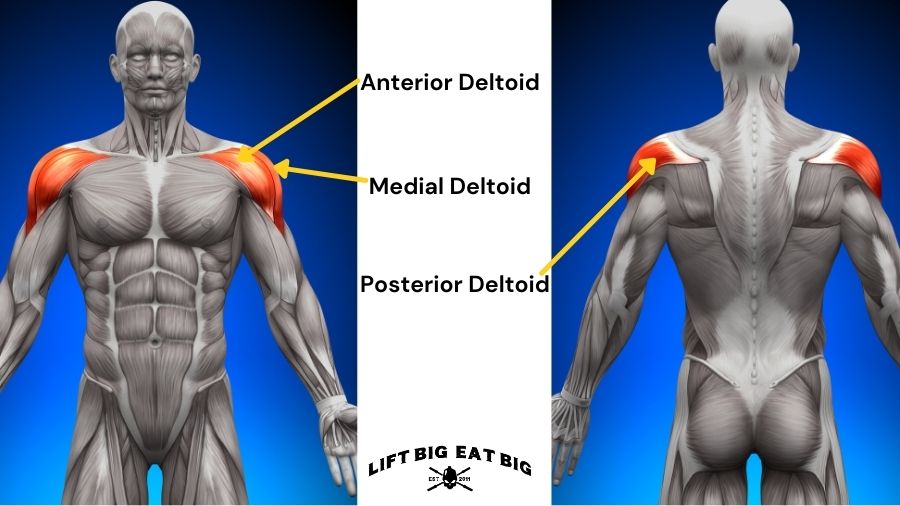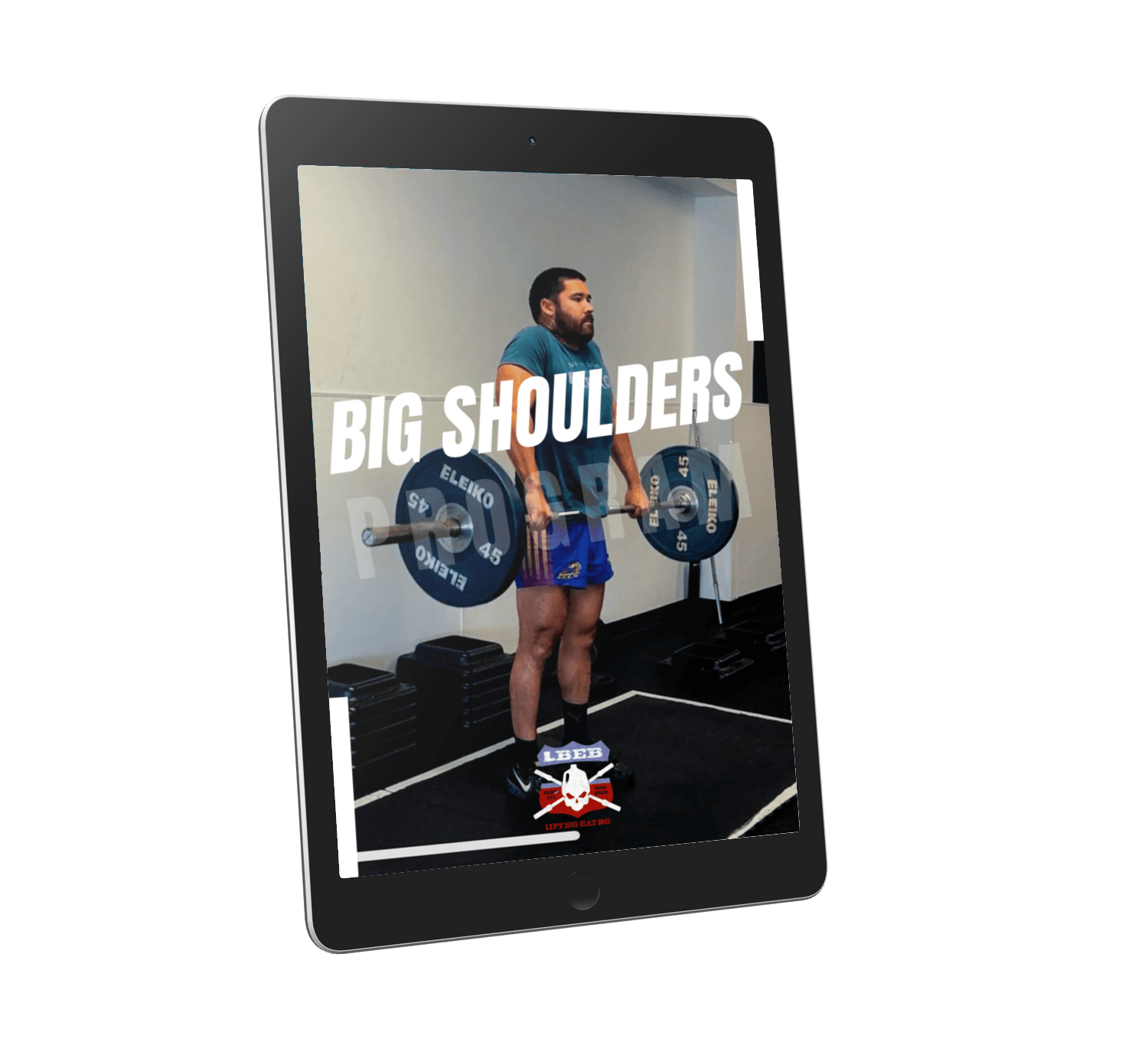The front delts take a beating within typical gym workout routines. Many lifters don’t realize that all pressing exercises heavily target the front delts. So, performing extra front delt exercises may be moot.
But for those looking to create a powerful-looking physique with powerful broad shoulders, extra front delt training may be necessary. It’s important to note that some side delt exercises like the lateral raise also target the front delts.
However, the front delt exercises in this article will only include exercises that primarily target the front deltoids. But to know which exercises do this, we need to understand some basic shoulder anatomy and function.
Table of Contents
Anatomy Of The Shoulder
The shoulder consists of three different muscles:
- Anterior deltoid (front)
- Medial deltoid (side)
- Posterior deltoid (rear)

The anterior or front deltoid is primarily responsible for shoulder flexion and horizontal adduction. That is raising your arm in front of you (e.g., front raise) and performing a chest fly motion [1,2]. This means that all chest exercises involve the front delts!
So, you’ll see some of the best front delt exercises listed below would also be considered some of the best chest exercises.
10 Best Front Delt Exercises For Mass
Front Raise
Walk into any commercial gym, and you’ll see someone performing dumbbell front raises in a wife-beater facing the mirror. It’s an easy exercise to perform and lights your shoulders on fire. The front raise loads the primary movement of the front delts shoulder flexion.
Due to the strength curve, the most challenging portion of the exercise is when the arm is parallel to the floor. And you’re not limited to using dumbbells. EZ bars, barbells, kettlebells, and even sandbags are great equipment options. Here’s how to get the most from the front raise:
- Hold a dumbbell in each hand while standing so your palms are resting against the front of your thighs.
- Keep your arms straight and raise them until they are parallel with the floor.
Simple as that. You can be seated to minimize any body momentum to make them more difficult.
Overhead Press
Now we’ve covered the sole isolation exercise for the front delts; it’s time to cover the big compound exercises that will pack slabs of muscle on your shoulders. The overhead press is also known as the press, military press, or shoulder press.
The front and side delts are the main shoulder muscles worked during the overhead press [3]. The overhead press elicits the highest front delt activation among compound exercises [1].
However, many bodybuilding programs won’t include overhead press in favor of direct shoulder isolation exercises due to how much horizontal pressing is done.
Further, the overhead press is harder on the joints than isolation exercises, especially when comparing the absolute loads used. Finally, heavy overhead pressing is harder to recover from than isolation exercises. Performing heavy overhead pressing can add unnecessary fatigue to the shoulders and triceps for a bodybuilder with a chest day and a separate shoulder day.
But it’s not all doom and gloom! If your goal isn’t purely to get on stage, but rather to build a physique worth taking your shirt off at the beach for, or to get insanely strong, then you should overhead press.
Here’s how to do it:
- Unrack the barbell with a slightly outside shoulder width group. Have your elbows slightly in front, so your triceps are “resting” on your lats.
- Create a big chest and press the barbell vertically. As you get past your forehead, push your head and body through.
- Finish with the straight arms overhead, so your biceps align with your ears.
You can also do these seated to remove the contribution from the lower body and further isolate the shoulders.
Overhead Press From Pins
This is one of my favorite overhead press variations. It allows you to overload your front delts as you’ll be performing a partial range of motion so you can lift heavier weights. For those purely interested in size, you may skip this exercise. But if you’re after brutally strong shoulders, this should be a staple. Here’s how:
- Set the pins in the power rack so the barbell rests approximately nose or forehead height.
- Create tension by pressing against the barbell. Once ready, press the barbell overhead and push your head and body through at the top.
Dumbbell Press
The dumbbell press is an alternative to the barbell overhead press that can help reduce muscular imbalances between shoulders and arms. Because they are two separate implements, you have the added benefit of improving shoulder stability. Here’s how to do it:
- Lift the dumbbells to the rack position. I recommend having your elbows facing slightly forward. This is the safest position to press from and the strongest position.
- Press the dumbbells vertically until the arms are straight.
Arnold Press
The Arnold press is unique to the traditional overhead press as it increases shoulder flexion range of motion. You may even find this variation feels easier on your shoulders if you have some discomfort with dumbbell pressing. Here’s how to do it:
- Hold two dumbbells in front of your face with palms facing toward you in a seated position.
- As you press, you rotate your arms, so your palms are facing away from you. It won’t be a directly vertical press. Instead, you’ll bring the arms apart first and then press.
Handstand Push-Up
Don’t have weights? No problem! The handstand push-up is a feat of strength not many can do. I prefer doing this with a partner as it’s easier to get your legs up the wall. But if you are confident getting to a handstand position, you can go solo. Here’s how:
- Place a soft cushion by the wall for your head, so you don’t bash it on the floor each rep.
- Place your hands on the floor and kick your legs up, so your heels are resting on the wall with straight legs.
- Slowly lower yourself until your head touches the pillow and press back to the top.
Incline Bench Press
There is a trend where the incline of the bench increases, so does the muscular activity of the front delts [4]. All degrees of incline allows for greater front delt activation so take advantage of it. Adjusting the bench to the notch above the 45° angle is your best bet when targeting the front delts. Here’s how to incline bench press:
- Set the incline bench, so the barbell is at eye level when racked. Pin your shoulder blades together to create a big chest.
- Unrack the bar and slowly lower it to your upper chest. Your elbows should be 45° from your torso, not flared to the side.
- Press the barbell back to the starting position.
You may have to stop an inch short of your chest, depending on your shoulder mobility.
Bench Press
The bench press is widely considered one of the most fundamental weight training exercises. Using large, powerful muscles to accomplish it results in a sharp-looking physique. While the bench press setup is an article of its own, here is a brief rundown of the key points to maximize the bench press.
- Set up, so the barbell is at eye level when racked. Pin your shoulder blades together to create a big chest.
- Unrack the bar and slowly lower it to your lower chest. Your elbows should be 45° from your torso, not flared to the side.
- Press the barbell back to the starting position by simultaneously pushing with your legs and arms and keeping your bum on the bench.
Half-Kneeling 1-Arm Landmine Press
Straight barbell exercises can be strenuous for some lifters to perform due to discomfort or previous injury. The half-kneeling 1-arm landmine press is the most shoulder-friendly pressing exercise you can do. I’ve used it extensively with athletes that have shoulder injuries. Here’s how to make the most of it:
- Place a pad under your knee in the half-kneeling position and pick the end of the barbell up. The other end should be in a landmine base or between two bumper platers to anchor it.
- Holding the end of the bar at shoulder height, press the barbell straight.
- Lean slightly forward as you press, so you finish with a straight line from your hand to your hips.
6 Ways
6 ways are a John Meadows special. If you’ve never tried these, you’re in for a treat. It combines the lateral raise and front raise in one exercise. Since the front delts are involved in both movements, the burn is next level. Here’s how to do it:
- Holding light dumbbells at your side, perform a lateral raise.
- At the top of the lateral raise, move your arms directly in front by bringing the dumbbells together.
- Perform a front raise until the dumbbells are now over your head.
- Reverse the pattern to the beginning.
Do You Need To Train Your Front Delts?
In my experience, you don’t need to train your front delts with isolation exercises directly. They get plenty of stimulation through heavy pressing and the various chest exercises you are performing. You should spend more time targeting the rear delts because they are often neglected and provide balance to your physique.
Further, overpowering front delts can lead to shoulder imbalances that increase your risk of injury. Since most lifters start their gym careers doing only chest and biceps, you may not need extra front delt exercises.
Summary
These are the best front delt exercises you can do for bigger shoulders. I reiterate that training the front delts with extra isolation exercises may not be necessary due to the sheer amount of work from compound pressing exercises.
However, isolation front delt exercises may be necessary for those wanting to build freakish physiques to show off on stage.
References
1. Campos, Y. A., Vianna, J. M., Guimarães, M. P., Oliveira, J. L., Hernández-Mosqueira, C., da Silva, S. F., & Marchetti, P. H. (2020). Different shoulder exercises affect the activation of deltoid portions in resistance-trained individuals. Journal of Human Kinetics, 75(1), 5-14.
2. Franke, A. R., Botton, C. E., Rodrigues, R., Pinto, R., & Lima, C. (2015). Analysis of anterior, middle and posterior deltoid activation during single and multijoint exercises. J Sports Med Phys Fitness, 55, 714-721.
3. Kroell, J., & Mike, J. (2017). Exploring the standing barbell overhead press. Strength & Conditioning Journal, 39(6), 70-75.
4. Trebs, A. A., Brandenburg, J. P., & Pitney, W. A. (2010). An electromyography analysis of 3 muscles surrounding the shoulder joint during the performance of a chest press exercise at several angles. The Journal of Strength & Conditioning Research, 24(7), 1925-1930.

